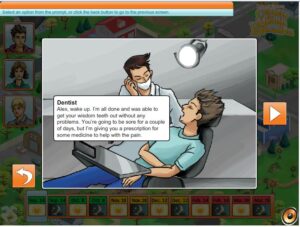Esmerelda, a young woman with curly hair and glasses can not take the fighting between her parents any longer. In an attempt to calm her anxiety and escape the tension in her home, she sneaks some of her dad’s opioid pain relievers and discovers…..
Floyd has never tried marijuana, but when he goes to study at his friend Brielle’s house, she is preparing a pipe of marijuana and invites Floyd to smoke with her. He decides…..
Ajay and his girlfriend Iris are home alone. Iris reaches over and Ajay says “Iris, I don’t think I’m ready for this yet”. She replies…….
Are you wondering what Esmerelda discovered? Do you want to know if Floyd decided to try marijuana? Did Ajay agree to more intimacy than he was ready for? If you are wondering, then you have experienced the way stories draw students into drug and sex education topics. Through using stories, students can experience situations that they may very likely face in the near future.
Helping students live healthier, happier and safer lives means facing difficult topics head on and delivering essential information in ways that resonate with kids today. The key to reaching young people, especially in topics that deal with sex and drugs, is to engage the young person so he or she is motivated to receive the information. In his article, “Why your brain loves good storytelling” from the Harvard Business Review, Paul J. Zak states, “When you want to motivate, persuade, or be remembered, start with a story”.
Zak explains that an amazing neural activity occurs when someone is engrossed in a story and that story can change the activity of people’s brains. Zak has discovered that a neurochemical called oxytocin enhances one’s sense of empathy and this allows us to understand how others are likely to react to a situation. If the story grabs the young person’s attention and creates tension—a problem to be solved or an issue that is important to the listener , then it is likely that attentive students will come to share the emotions of the characters in it.
Research suggests that when we hear a story, “not only are the language processing parts in our brain activated, but any other area in our brain that we would use when experiencing the events of the story are, too.” For example, sensory details like “Esmerelda was distraught and angry” engage a listener’s sensory cortex. Action words like “chug the shots down, Leonard” engage the motor cortex, all leading to a more connected and richer experience of the message. In short, the more a speaker conveys information in story form, the closer the listener’s experience and understanding will be to what the speaker actually intended.
At Candor Health Education, our newly redeveloped programs are story-based learning. These programs incorporate a class-period of e-learning experiences before the Candor Health Educator visits their class. They meet the characters and are introduced to the beginning of the story during the eLearning. Professor Watts, specialist in middle school education, explains that storytelling brings facts to life and triggers memory and emotion. For these reasons, we use stories in the classroom. Watts says, “A story can put your whole brain to work.” When we listen to a story, our brains often envision the action. We see through the lens of our own experiences and form our own emotional attachment, so students connect to it and invest in it. We want students to remember something important. We want them to listen. We want them to learn.
In our new Puberty I programs, 4th or 5th grade students follow along as characters their age interact with older siblings who are navigating the journey through puberty. Students learn about the changes of puberty by watching these older characters, Ethel and Clyde as they experience them. The Puberty II program continues the stories of Ethel and Clyde as they learn about empathy, compassion, sincere apologies and self-identity and continue their puberty journey. Students are excited to meet the characters. The stories feature characters of various ethnicities, allowing students to see themselves in the stories. One south-side class was thrilled to know that students around the Chicago area followed the African-American brothers Michael and Clyde navigate puberty.
The newly revised Science Behind Drugs for 6th /7th grade and 8th grade follow the same group of characters as students consider the influences on the characters at parties and learn about refusal skills. Students have opportunities to analyze influential music and images and practice skills. The 8th grade class focuses on 8 characters’ goals (which are probably the same goals as our students) and examine how the characters’ decisions about drug use impact their goals and their lives. Factual information is woven into the 8th grade story using a special character, Floyd’s grandfather who is a local pharmacist. Grandpa provides a way to integrate essential information while still maintaining the story line.
We want our students to be motivated to learn essential information about their sexuality and about drugs in our society. We want them to remember this information and the skills they learn in class so that they will use it to live healthier, happier and safer lives. So how do we do this? We “started with a story.”

Written by: Rose Tenuta-Health Educator, Candor Health Education
